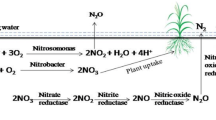Abstract
Measurements of greenhouse gases CO2, CH4, and N2O were made by static chamber-gas Chromatograph in Inner Mongolia. Results indicate that with growing seasons, the daily variation patterns of emission/uptake of greenhouse gases differ greatly in the prairie ecosystem. The peak of seasonal emission/uptake of three greenhouse gases occurs at the molting period in spring when soil moisture is high and rainfall is rich. The daily emissions of CO2 from steppe vegetation in growing seasons are low during the daytime and high at night. Higher temperatures are advantageous to emission of CO2, as aboveground biomass determines the amount of CO2 photosynthetic uptake. The key factors that influence the daily variation patterns of CH4 uptake and N2O emission in serniarid grassland are soil moisture and the oxygen supplying condition, while the changes in daily temperature mainly affect the range of daily variations. The seasonal changes of N2O emission are positively related to seasonal change in soil moisture. Free grazing reduces the daily mean deviation of exchange rates of CO2, N2O, and CH4, but it decreases the amount of annual emission/uptake of N2O and CH4 yet it increases the annual emission of CO2.
Similar content being viewed by others
References
Chen Z. Z., 1988: Topography and climale of Xilin River Basin. Research on Grassland Ecosystem, Science Prsss, Beijing, 3, 13–22 (in Chinese).
Chen G. X., Shang S. H., und Yu K. W., 1990: N2O emission of vegetation. Chinese Journal of Applied Ecology, 1(1), 94 96 (in Chinese).
Du R., Chen G. C, Lü D. R., and Wang G. X., 1997: The primary study on the effect of soil moisture and temperature on Greenhouse Gases fluxes from Aneurolepidium Chinense and Stipa Grandis typical prairic soil-plant system. Climatic and Environmental Research, 2(3), 273–279 (in Chinese).
Huang Y., R. L. Sass, and F. M. Fisher, 1998: A somiempirical model of methane emission from flooded rice paddy soils. Global Change Biology, 4, 247–268.
Jia S. H., 1999: Changes of soil physical attributes along grazing gradient. Research on Grassland Ecosystem, Science Press, Beijing, 3, 12–16 (in Chinese).
Li Y., and Lin E. D., 2000: Effect of variations in land use pattern of natural grassland on its CO2 emission and CH4 uptake. Rural Eco-Environment, 16(2), 14–16 (in Chinese).
Martin K., and C. Ralf, 1995: Effect of CH4 concentrations and soil conditions on the induction of CH4 oxidation activity. Soil Bio and Biochem, 27, 1517–1527.
Mosier, A., D. Schimel, and D. Valentine, 1991: Methane and nitrous oxide fluxes in native, fertilized and cultivated grasslands. Letters to Nature, 350, 330–332.
Wang M. X., and Shangguan X. J., 1996: CH4 emission from various rice fields in PR China. Theoretical and Applied Climatology, 55(1), 129–138.
Wang Y. F., Zhen Z. Z., and Wang S. P., 1997a: Studies on the N2O emission from the typical grassland in the inner mongolia. Climatic and Environmental Research, 3, 280–284 (in Chinese).
Wang Y. S., Wang M. X., and Zheng X. H., 1997b: Automatic monitoring of N2O emission in farmlands. Analysis and Testing Technology and Instruments, 3(1), 10–15 (in Chinese).
Wang Y. S., Wang M. X., and Zheng X. H., 1997c: An automated system for measurement of N2O/CH4 emission fluxes. Journal of the Graduate School of University of Science and Technology of China, 14(1), 17–22 (in Chinese).
Wang Y. S., Ji B. M., and Wang M. X., 2000: A method of measurement the exchange rate of greenhouse gases between field and atmosphere in semiarid grassland. Chinese Journal of Environmental Sciences, 21(3), 6–10 (in Chinese).
Zheng X. H., Wang M. X., Wang Y. S., Shen R. X., Shangguan X. J., Heyer J., Kögge M., Papen H., Jin J. S., and Li L. T., 1997: N2O and CH4 emission from rice paddies in Southeast China. Chinese Journal of Atmospheric Sciences, 21(2), 167–174.
Zheng X. H., Wang M. X., and Wang Y. S., 1999: Characters of greenhouse gas (N2O, NO, CH4) emissions from croplands of Southeast China. World Resource Review, 11(2), 229–246.
Author information
Authors and Affiliations
Corresponding author
Rights and permissions
About this article
Cite this article
Wang, Y., Hu, Y., Ji, B. et al. An Investigation on the Relationship Between Emission/Uptake of Greenhouse Gases and Environmental Factors in Serniarid Grassland. Adv. Atmos. Sci. 20, 119–127 (2003). https://doi.org/10.1007/BF03342056
Received:
Revised:
Published:
Issue Date:
DOI: https://doi.org/10.1007/BF03342056




